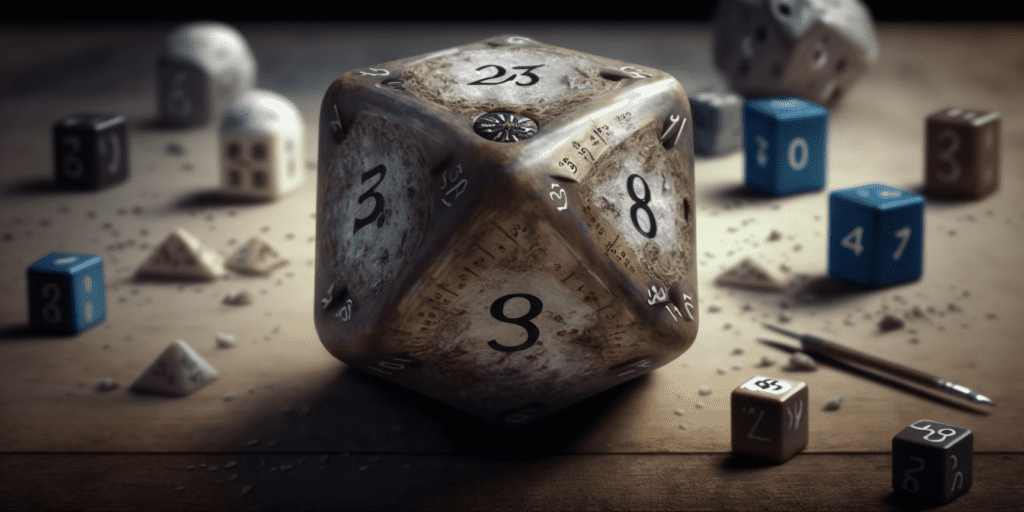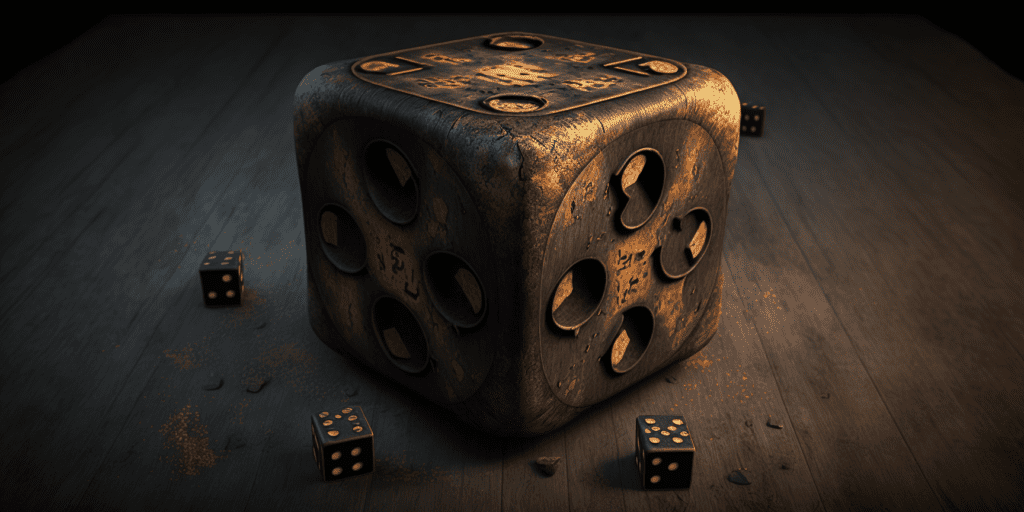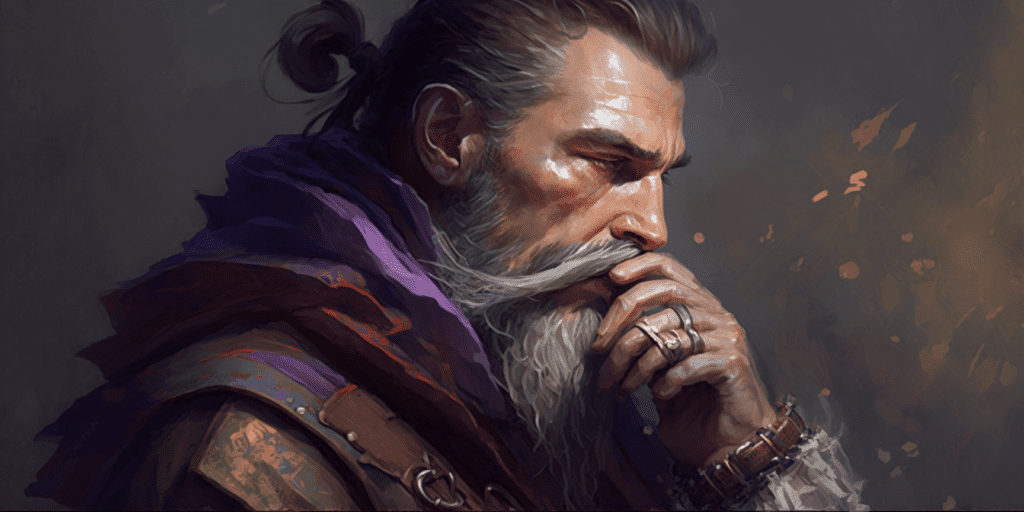In DnD, we use dice to determine actions and outcomes. It’s not completely obvious to a beginner how this works, or how many dice you should have. After all, there are so many different types of dice.
That’s why I made this article – to assist any prospective players who have questions about dice in DnD. So, how many dice are needed to play the game of DnD?
The absolute minimum to play DnD is a 7-dice set. This includes one d4, d6, d8, two d10, one d12, and a d20. Technically, you don’t need physical dice, as there is plenty of free digital dice to use that work fine. However, most players recommend getting two sets of 7 dice if you do get dice. How many dice you need also depends on what class you’re playing.
Now that you know how many dice are the minimum to play the game correctly, keep reading to find out why we use so many dice, what different dice are for, and much more.
How Many Dice Should You Have In DnD?

As I mentioned earlier, a 7-dice set includes one d4, d6, d8, two d10, one d12, and a d20. Why does it include two d10 but only one of the others? Well, one of the d10s is used for percentile rolls. When you roll for certain skills, you use a percentile from 0-100 to roll for success.
You would then use your one percentile die that is numbered 00-90 (going up in tens, so 00, 10, 20, etc) and your regular d10 dice to determine your number from 1-100 instead of getting a D100 die.
Another thing to note is that the number of recommended dice depends on what class you’re playing. For example, spellcasters normally require more dice than say a fighter. Warlocks require a lot of d10s, and some spells with other spellcasters such as the sorcerer require copious amounts of dice for one spell.
That being said, it is hard to give you the perfect number of dice to get since I can’t know what class you’re playing. My recommendation is to get 4 dice for each number.
This way, you’re pretty much safe no matter what class you’re playing, or if you decide to switch from one class that doesn’t use that many dice to a class that uses a lot of them.
I would also recommend getting the sets of dice in different colors. This can serve you in a few different ways. For one, you know what dice are yours. Imagine a party of 3-4 players with a bunch of dice of the same color. Yikes.
Specifically, if you’re all throwing dice at roughly the same time to speed up rolls, it’s fair to say that it’s a good thing to know what dice are yours.
Why Does DnD Need So Many Dice?

Let’s get into why DnD needs so many dice and their uses. A common thing for players is to have different dice for different characters. This provides a cool flavor to the character, giving it some identity.
Collecting dice is another very common theme you see with DnD players. When players have gotten their needed literature for DnD, they like to splash some cash on dice. They look cool, and they serve a function.
So, why does DnD require so many different dice? Let’s see what the different dice do, from the D4 to the D20.
- D4 – The d4 is used for attacks that deal a lower amount of damage most of the time. Fists, some weaker spells, and smaller blades.
- D6 – This is a dice you already know of. It is the most used die outside of games such as DnD. In DnD, you use it to create a PC’s ability score by rolling four of them and then disposing of the lowest number. The d6 is also used to calculate damage for some spells (meteor swarm, for example).
- D8 – This dice is mostly used for weapon damage and spell damage. Not much more to add.
- D10 – The d10 is also used for spells of different kinds, and as I touched on earlier, you use two of them to generate a number between 1-100.
- D12 – This dice sees decidedly fewer rolls than the other ones. Don’t confuse it with the d20. Most DMs won’t let you reroll.
- D20 – The d20 is arguably the most important dice, even if all of the dice are used in some capacity. Even the system that DnD is based on is called the d20 system. The d20 is used for saving throws, attack rolls, and skill and ability checks.
Finally, getting a few of each of these can be useful for time-saving. Rather than rolling one dice a bunch of times, roll all of the dice of that number at the same time. DnD largely consists of long sessions, so saving time where you can is usually appreciated.
What Is A D100 Dice Used For?
Earlier I mentioned that you could use two d10 dice to roll from 1-100, and the other option for this is doing this roll with a d100 – a dice with a hundred sides. It’s bigger than a usual dice and has a more rounded shape to fit all the numbers.
A lot of the use a d100 dice would have is for a DM, to roll everything from potion mixing to teleportation.
Read more: How Many Dice Should A DM Have?
A d100 is not generally needed as you can use the other option to roll 1-100, but as I said, a lot of DMs like to have them.
Can You Play DnD With One Dice Set?
Absolutely, one dice set is fine. You can roll a dice multiple times if more rolls of the same dice number are needed. Players generally like it when every player has their own dice, however, so I wouldn’t recommend lending dice from friends too much.
Another thing players generally like is to have multiple dice sets – it is not strictly needed as I mentioned, but it does save time and is just generally convenient.
Read more: Metal Vs. Plastic Dice
What Happens When You Roll A 20 In DnD?
What happens when you roll a d20 depends on what type of roll you’re performing. If doing an attack roll, a 20 roll will result in an automatic success and a critical strike. Here’s how the basic rules made by Wizards of the Coast explain it:
“If the d20 roll for an attack is a 20, the attack hits regardless of any modifiers or the target’s AC. This is called a critical hit”
When it comes to ability and save checks, a natural 20 (that’s what we call the 20 rolls on a d20) will not result in automatic success – this is a special rule specifically for attacking.
What Does Rolling A 1 In DnD Mean?
Rolling a 1 on a d20 is the same as rolling a 20 – if you roll a 1 on an attack roll, this will result in automatic failure of the attempt. This does not apply to the other type of checks mentioned.
As with the 20 rolls, rolling a 1 does not mean automatic failure of a skill check or saving throw. It just considerably lowers your chance of a good outcome, depending on the tweaks/modifications for that roll.
What Material Is Best For DnD Dice?

This question is subjective. There’s no such thing as the best material for dice, but there are certainly things such as price, durability, weightedness, and style.
The cheapest dice for DnD are the plastic ones. They have fine durability, they come in a load of different colors, and are cheap. I’d wager that most players have plastic dice.
Metal dice are another fairly popular option. They have a different feel to them when you’re throwing them, which some players appreciate. Remember, we use these dice for roleplaying, and having certain dice provides immersion for some players.
The most important thing about dice is that they work. If the weightedness is wrong, or the edges are uneven, you should not use those dice, but refund them and get new ones.
You Might Also Like: What Are DnD Dice Towers For?

